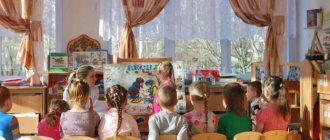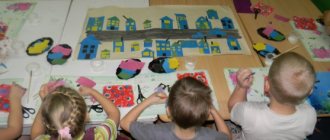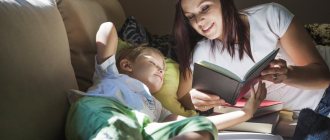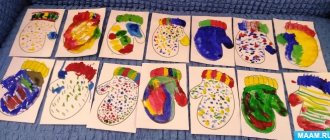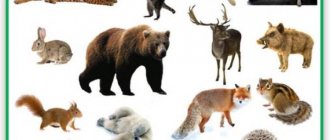Summary of an ecology lesson on the topic “The importance of the sun in our lives”
For middle group children
Program content. To draw children's attention to the constant presence of the sun, warmth, light in our human lives, to evoke an emotional attitude towards the sun, to its role in the life of humans, birds and animals. To acquaint children with the behavioral and visual characteristics of animals living in conditions of lack of light or in the complete absence of light. Give first ideas about environmental protection.
Material and equipment. A thick blanket, a painted sun, a figurine of a person, a table lamp, a bag with various dry herbs, various small objects, mirrors for each child, musical accompaniment.
Progress of the lesson.
What is the weather today: sunny or cloudy. Is the sun shining? What mood do children have in sunny weather and what in cloudy weather? Psycho-gymnastics “Sunny - Cloudy” is carried out
Why do we need the sun? What does it do for us? /warms, shines/. Where does the sun go in the evening? What do we do at night? Where does the sun come from in the morning? /wakes up/.
Game "Day - Night". At the teacher’s command, it’s night / the children fall asleep /, at the command of day, they wake up.
What would happen if the sun went to sleep and never returned? /frozen/. Psycho-gymnastics “Cold”.
To feel how we would live without sunlight, we need to be in complete darkness. To play, take a thick blanket, children sit on the floor and cover themselves with the blanket. What do they see? Day comes, the blanket is removed, and sunlight helps children distinguish objects. Why couldn't children see, because they have eyes? A person sees when he has light. If there were no light, then we would not need eyes.
How does the sun get through our window? That he has? /rays/. Do you want to play with a ray of sunshine? How can you play with the beam? You can catch him. How? /mirror/. The teacher catches a ray of sunshine with a mirror, invites the children to catch the ray, /what is a ray of sunshine?/ what is a sunbeam? A ray of sunshine is reflected from the mirror and turns into a sunbeam. The game “sun bunnies” children turn into sun bunnies and flutter like sun bunnies to the accompaniment of music.
Who else besides humans needs the sun? /animals/, Why? But there are animals that see in the dark. Who is this? /cat, owl/, How do they hunt? Game "Animals in the Dark". The child is blindfolded, the teacher gives an object into his hands and asks him to guess what exactly he received. It is advisable for the item to have a scent, /it can be dried grass, fresh pine cone, lemon or apple/. Being in the dark, the child will try to blindly identify the proposed object. How will he do this? Touch the object with your hands, stroke it, turn it, smell it.
After the children identify objects in the dark, the teacher discusses with them how they did it. Did they need eyes? But there are animals that live where there is practically no light. For example: underground in deep caves, at the bottom of the ocean. Indeed, their eyes turn into small slits /mole/.
Who else needs sunlight? /plants/. What happens if a plant falls into complete darkness? /will die/. The teacher demonstrates a plant that grew in the dark and a plant that grew in the light. Children find the difference in the color of the plant. They draw a conclusion.
Where can the sun go? /night, cloud, smoke/. What should we do to prevent the sun from disappearing? /children answer/. In the meantime, we are friends with the sun.
Psycho-gymnastics “Solar warmth” is carried out. To the accompaniment of calm music, children expose their faces to the sun, close their eyes, and relax.
In order for children to clearly understand how the sun is covered by a cloud and a shadow falls on a person, an experiment is carried out. Take a burning table lamp, a small man, and insert a flat circle between them. A shadow appears on a person.
Summary of a conversation with parents “The sun is good, the sun is bad!”
Consultation for parents on the topic:
“The sun is good, the sun is bad!”
Target:
Informing parents on this topic.
Tasks:
Inform about the rules for children’s exposure to the sun;
Expand parents' knowledge about the effects of sun rays on children's bodies.
With the onset of hot summer days, everyone is in a hurry to spend more time outdoors. The sun has a beneficial effect on children's bodies. Under the influence of sunlight, vitamin D is produced, which is so necessary for the prevention of rickets, the immune and nervous system is strengthened, metabolism is normalized, and serotonin is produced, which is called the “hormone of joy.” But the sun can become not only your child’s friend, but also his worst enemy. We advise you to strictly follow the rules for keeping children in the sun.
Choice of clothes
Wearing the right clothing will help protect your baby from overheating. Natural cotton and linen will cope best with this. The clothes you dress your child should be light, the cut of the clothes should be loose enough so as not to interfere with breathing and movements. If you are planning long walks, be sure to take long sleeves with you to protect your baby from sun rays (burns).
Sunburn is a burn that occurs as a result of exposure of the skin to ultraviolet rays. The symptoms of a sunburn are the same as those of a burn from a hot object, ranging from redness to blisters. Only they do not appear immediately, but after a few hours - which is why they are dangerous.
Sunburn in a child, first aid
1. Move your child into the shade.
2. Be sure to call an ambulance or consult a doctor yourself if the following phenomena occur:
chills, fever up to 38.5°C and above;
headache;
swelling on the face and hands;
blistering of the skin (i.e., second-degree burn);
first degree burn (redness affecting a large surface of the body;
presence of signs of infection (severe redness of the skin, swelling, pus);
nausea, vomiting, lethargy;
loss of consciousness.
3. Before the ambulance arrives (or in case of a minor sunburn, when the child is not seriously injured), take the following measures:
To relieve pain, moisten or irrigate the affected area of skin with cool water (as it evaporates, it will cool the skin); Place a towel soaked in cool water on the child's shoulders or wrap him in a damp towel for 10-15 minutes. You can repeat this procedure several times with an interval of 30 minutes, just do not overcool the child.
Treat your skin with cosmetics intended for use after sunbathing or medicinal aerosols against burns, if you have them on hand.
2) Headdress
On sunny days in summer, be sure to wear a hat for your child! This can be a light Panama hat or a cotton scarf; a straw hat will also do. This will protect both your head and eyes from the harmful effects of sunlight. The main thing is that the scalp breathes freely.
Monitor your sun exposure
The best time for sunbathing is from 8.00 to 11.00 in the morning and after 16.00 in the evening. Gradually increase your time in the sun. Start with 5 minutes, daily increase the duration of solar treatments by 3 minutes, bring it up to 30 minutes a day.
Doctors consider air temperatures above 30 degrees to be a contraindication to sunbathing.
Symptoms of overheating in the sun
Symptoms of a child overheating in the sun often resemble the symptoms of the onset of an inflammatory disease: the child becomes lethargic (or, conversely, very excited, shakes his head from side to side or throws it back (as with a headache), his body temperature rises. In children or “reactive In children, the only signs of overheating can be psychomotor agitation and a sudden rise in body temperature.
In any case, if you suspect sunstroke or heatstroke, move your child to a cool, shaded area.
Help for heat stroke is simple, but must be provided in a timely manner. If possible, of course it is better to call an ambulance. But even before the ambulance arrives, you must help the child cope with overheating.
1. First of all, move the child to a cool room.
2. Give a horizontal position.
3. Completely undress the child.
4. The child must be cooled as soon as possible. The most effective way is water cooling.
5. The next important step is to give the child enough cool liquid to drink.
Drinking regime
It is very important to monitor your child’s drinking regime. After all, water is the most important component of the body. Offer your baby something to drink more often. It is best to use boiled or bottled water without gas. You can offer an unsweetened rosehip decoction or compote, but any drink must be warm. Let children drink as much as they require. The daily drinking water requirement for a child aged three to seven years is approximately 1.2–1.7 liters.
Love your children and remember that everything is healthy in moderation!
Summary of an environmental lesson in the senior group “The Sun and We”
Transcript
1 MUNICIPAL STATE PRESCHOOL EDUCATIONAL INSTITUTION KINDERGARTEN “FAIRY TALE” COMBINED TYPE KUPINSKY DISTRICT Abstract of an environmental lesson in the senior group “The Sun and We” Prepared and conducted by teacher Khmelnitskaya Ya.G.
2 Objectives: The theme of the lesson “The Sun and Us” is to reveal and expand children’s ideas about the sun, as well as the great importance of light and warmth for all life on earth; - introduce the words into the children’s dictionary: source of light and heat; - develop the ability to observe, reason, draw conclusions; - develop memory, attention, critical thinking; — cultivate a love of nature, strengthen the ability to feel emotional warmth and joy; Give each other a smile, guys. We collect smiles As soon as we accumulate more Progress of the lesson We don’t hide them, we don’t hide them - we’ll give them all back! Now let’s sit down nicely and get ready for class. -Guys, remind me what time of year it is? (on the board are illustrations of spring) (Spring) When we go for a walk, we observed the changes in nature at this time of year. What happens in nature with the arrival of spring? (the sun is shining brighter, birds are singing, dripping from the roofs, icicles are hanging, it has become warmer) - That’s right, with the arrival of spring everything comes to life, the birds are singing. And all this because the sun shines brighter and warms more than in winter. Preparing to study new material - Guys, guess the riddle You warm the whole world And you don’t know fatigue You smile in the window And everyone calls you (the sun) - Look, children, what’s in my hands? What geometric figure is this? (circle) - Well done, that’s right - it’s a circle. What color is the circle?
3 (yellow) - That's right, yellow. Look and think, what does the yellow circle look like? (showing pictures) (like an orange, like a ball, like an apple, like the sun) - That’s right, our circle looks like the sun. - But what is our sun missing? (rays) - Let's give the sun some rays, but not just like that, but with each ray saying kind words about the sun. - Sunny, what is it like? (gentle sun) - That's right, let's add the first ray to the gentle sun. Also, what kind of sun do we have? (warm, radiant, bright, cheerful, etc.) (with each word the children add rays and pronounce the words) - This is the kind of sun we got: warm, bright, radiant. The sun is a source of light and heat. It warms, gives warmth. And who does it give warmth to? Animals, plants, people. We recently planted onions with you. Let's look at our bow. Let's compare the onions from the windowsill and take the onions out of the closet. What happened to him? The onion that stood on the windowsill in the sun sprouted and produced green, plump feathers, but the onion that we put in the closet, where there is no sunlight, is just beginning to sprout and the tips of the feathers are already turning yellow. Why such difference? That's right, because one bow stood in the sun and the other in the dark. From this experience we can conclude that plants and all living things on earth need light and warmth. Finger game gymnastics - Let's draw a sun in the air. I draw a yellow circle, a lot of sticks around. - Look guys, what can we add to the middle of the circle? I’ll tell you a riddle: We all call the house where our tongue lives (mouth). That’s right, now we’ll give the sun a mouth. (children glue their mouths) - Listen and guess another riddle: to hit the target at least once you need a well-aimed (eye) (children glue the eyes of the sun)
4 Exercise “Smile” - What a wonderful sun we got. It smiles at us, its rays warm us. We are warm, pleasant, joyful. Let's make things warmer and brighter around us. Let's smile at the sun, the meadow and any blade of grass. We will smile at each other just like that now with you. Physical exercise (music sounds) By night the sun will set lower, lower, lower In the morning the sun rises higher, higher, higher Good, good the sun laughs And under the sun we all have fun living! (children perform movements together with the sun) And now, guys, let's tell a poem about the sun. It will hear us and will no longer hide behind the clouds. (children read a poem together) - Well done, you brought joy to the sun. There are not only riddles and poems about the sun, but also a lot of proverbs and sayings. The sun rises, and so the day comes. Think about how you understand this proverb. The sun wakes up in the morning, the day comes, it becomes warm and light. Bottom line. -Today in class we learned a lot about the sun. The sun's rays are good for human health. In nature, the sun gives warmth and light. In spring, the sun comes closer to the earth, the days become longer, everything blooms and enjoys life. Why does the sun shine for us? (so that it is light and warm, the plants grow and bloom) - This concludes our lesson.
5
6
Topic: “Visiting the Sun” (01.06-02.06)
Conversations “The Magical World of Theatre”, “How to Behave in the Theatre”.Target
: give children an idea of the theater; expand knowledge of theater as an art form; introduce types of theaters; cultivate an emotionally positive attitude towards the theater; remind you of the rules of behavior in the theater.
Watch a theatrical performance at a local puppet theater.
Plot-role-playing game “We came to the theater.”
Target:
introduce the rules of behavior in the theater; arouse interest and desire to play (play the role of “cashier”, “ticketer”, “spectator”, “actor”); cultivate friendly relationships.
Dramatization game “Come up with a funny and sad dialogue between Mouse and Teddy Bear.”
Target:
develop communication skills; diversify intonation expressiveness.
Game “We won’t tell you what we did”
Target:
develop resourcefulness and imagination.
Productive activity: collective application “Someone lives in a little house.”
Target:
improve the ability to use scissors, develop fine motor skills of the fingers.
Listening to the audio tale “The Wolf and the Seven Little Goats.”
Theatrical performance for kids “The Wolf and the Little Goats”.
Target:
develop artistry and the ability to speak in public.
Sky observation.
Goal: to introduce children to various natural phenomena. Teach to note the state of the sky /clear, cloudy, cloudy/. Activate the words: clouds, clouds.
Bird watching.
Goal: to consolidate children’s knowledge about the habits of birds and their appearance. Create a desire to care for birds.
Tree watching.
Goal: to consolidate knowledge about various deciduous and coniferous trees. Cultivate a caring attitude towards plants.
Labor assignment : collect pebbles in baskets.
Goal: to teach children to perform basic work tasks.
Labor assignment : collect toys after a walk in the basket.
Goal: to teach children to perform simple work tasks.
Wellness exercises after sleep: self-massage
P/n: “Shaggy Dog.” Goal: to strengthen children’s ability to listen carefully to the text, pronounce it together with the teacher. Start moving after the last words.
D/i : “Find a pair.” Goal: classify objects by color/shape/.
D/i : “Magic bag”. Purpose: to strengthen children’s ability to distinguish objects by touch and name them.
P/n : “Sunshine and rain.” Purpose: to train children to disperse, to quickly respond to a signal.
P/n : “Airplanes.” Purpose: to practice running in all directions, without bumping into each other, to respond to a signal.
Round dance game : “Mice dance in a round dance.” Purpose: to practice performing various movements.
Table theater “The Three Little Pigs”, “Little Red Riding Hood” - goal: to cultivate an emotionally positive attitude towards the theater.
